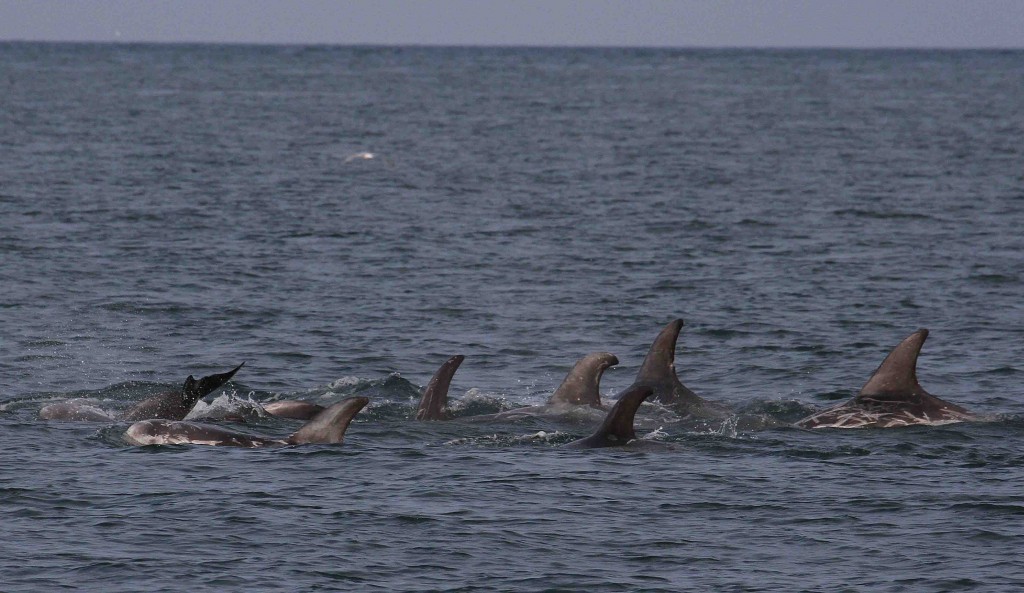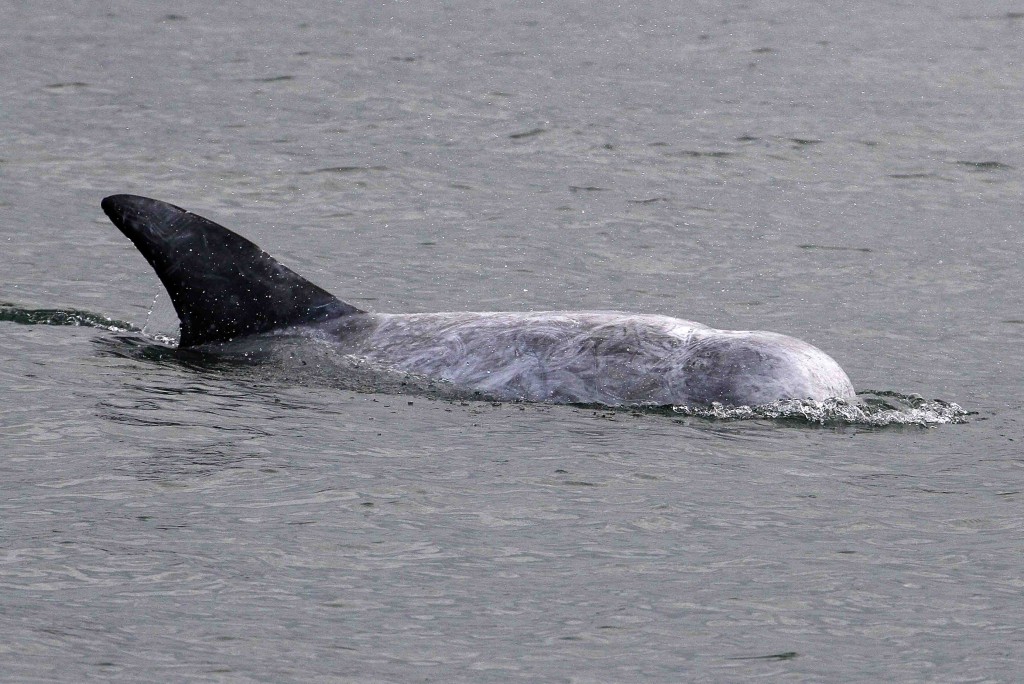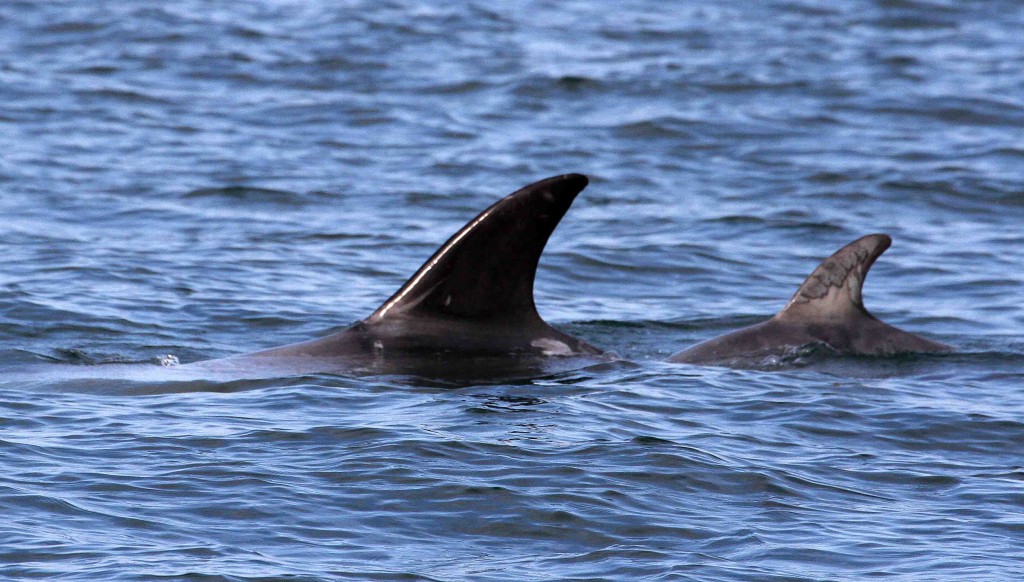Yesterday, the largest group of Risso’s dolphins ever recorded off the North Wales coast were recorded by Sea Watch Foundation. If you didn’t already know, Sea Watch monitors whales, dolphins and porpoises all around the UK and has their main base in Wales. Returning to his home in Bull Bay on the north coast of Anglesey late on Saturday afternoon, Sea Watch’s Director, Dr Peter Evans, was greeted by a small group of Risso’s dolphins right in front of his house that overlooks the sea. In Britain, Risso’s dolphins are uncommon, occurring in relatively few places mainly along our western seaboard. This sighting was followed the next morning by a number of phone calls reporting more Risso’s dolphin sightings from nearby Point Lynas. Peter drove out to look at them and saw another small group. Linking up with local boatman, Jon Shaw, at lunchtime they both went out in his vessel, Seekat C, in the hopes they might find the animals. No sooner had they gone out of the harbour at Amlwch when they came upon another small group. After travelling back and forth between Point Lynas in the east and Porthwen in the west, guided by land observations telephoned through to them by observers Mike Thompson and Andy Sherriff at strategic points on the coast, it became clear that there were several groups of this species, and by the end, their tally was over fifty making this an exceptional record. Normally in this area, only very small numbers are seen every year. The animals were generally moving westwards stopping regularly to look for small squid and octopus that form their main prey. On occasions they would bunch together into bigger groups and social behaviour would be observed.
“Many of the dolphins were younger animals, much darker than the mature white individuals,” said Dr Evans. “These were engaged in lots of playful behaviour, swimming in a tight bunch often in direct contact with one another. The dolphins showed some segregation by age with younger animals forming separate groups.”
Some of the many Risso’s dolphins in Bull Bay, North Anglesey. Photo by Dr Peter Evans.
Peter and Jon took many pictures of different individuals for use in Sea Watch’s scientific studies of the species. By examining the unique scratch marks which develop on the animals over time, they are able to build up a catalogue of individuals and document their movements and lifestyle choices (see pictures below). This information can be used, in turn, to protect the animals from habitat degradation and disturbance.
One of the Anglesey Risso’s dolphins displaying its blunt head and white colouration. Photo by Dr Peter Evans.
Risso’s dolphins are a large species with a blunt head. They are dark grey in colour which becomes much paler over time through their interactions with other Risso’s dolphins, and from the sharp beaks of squid and octopus (their main prey source). Old individuals can appear almost totally white and there was one very white individual spotted during this sighting.
North Wales has a particularly rich cetacean fauna (which includes whales, dolphins and porpoises). Wildlife-watchers regularly see harbour porpoise and bottlenose dolphins from the shores of North Wales. Further south, Cardigan Bay is home to the UK’s largest semi-resident population of bottlenose dolphin in summer months, and the coast of South Wales has frequent reports of harbour porpoises, and further offshore, common dolphins too. Risso’s dolphins on the other hand, have a very patchy distribution, occurring mainly off Pembrokeshire and the Llyn Peninsula (particularly around Bardsey). Off Anglesey, they are regularly seen in small numbers (generally less than a dozen) between September and November, but yesterday’s sighting marks the largest ever group spotted in this region.
This photo clearly shows the ‘rake’ marks over the body, the distinctive bulbous head, and tall dorsal fin.
Photo by Dr Peter Evans
“Photo matches of individual Risso’s dolphins show that they are very site faithful, the same animals returning year after year to exactly the same spot.” says Dr Evans. “However, they can also range over wide areas and the same individuals have been seen off Pembrokeshire, the Llyn Peninsula, Anglesey and the Isle of Man, and some even travel on up to West Scotland.”
“Now’s the time to head to the coast of Anglesey and beyond to see you if you can spot some of these amazing creatures of the deep” urges Sea Watch Foundation’s Sightings Officer, Kathy James. “If you are lucky enough to spot a Risso’s dolphin, or a fin of any kind, then please report your sighting to us here at Sea Watch. All of your reports help us to protect these magnificent animals going forwards”.
Female Risso’s dolphin and calf photographed off Bull Bay by Dr Peter Evans yesterday.
If you live in Wales and would be interested in joining the ranks of the ‘Welsh Sea Watchers’ then you can actively participate in monitoring cetaceans around the coast of Wales. Interested parties should email mathew.clough@seawatchfoundation.org.uk to find out how they can take part.




























